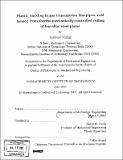| dc.contributor.advisor | David M. Parks. | en_US |
| dc.contributor.author | Vishal, Vaibhaw, 1978- | en_US |
| dc.contributor.other | Massachusetts Institute of Technology. Dept. of Mechanical Engineering. | en_US |
| dc.date.accessioned | 2009-01-23T14:53:39Z | |
| dc.date.available | 2009-01-23T14:53:39Z | |
| dc.date.copyright | 2007 | en_US |
| dc.date.issued | 2007 | en_US |
| dc.identifier.uri | http://hdl.handle.net/1721.1/40359 | |
| dc.description | Thesis (Ph. D.)--Massachusetts Institute of Technology, Dept. of Mechanical Engineering, 2007. | en_US |
| dc.description | Includes bibliographical references (leaves 157-164). | en_US |
| dc.description.abstract | The need for energy infrastructure has led to transportation of gases over long distances. The strength-grade of pipeline steels used for transportation of gases has been increasing to reduce the cost of the overall pipeline system. Along with higher strength, adequate fracture toughness and resistance to plastic buckling are required of pipes installed in earthquake- or frost-prone regions. To get higher strength with adequate deformability in low-alloy pipeline steels, plates for pipes are typically made today by thermo-mechanically-controlled rolling processes, which introduce strong crystallographic texture and anisotropy in the pipes. The plates are then cold-formed into pipes, which introduces further anisotropy and residual stresses in the pipe. In the current work, effects of various steps of the pipe manufacturing process, such as rolling, cold forming, etc., on residual stress, hardening moduli, plastic anisotropy, and eventually, to the buckling resistance of the pipe, are studied. Effects of various types of geometric perturbation on plastic buckling response of pipes are also studied. | en_US |
| dc.description.abstract | (cont.) Due to the crystallographic texture and cold-forming, crystal plasticity-based constitutive models instead of Mises plasticity-based constitutive models may be better suited to model the pipe. In the current work, crystal plasticity-based material models are used to predict the buckling response of pipes. Results show that the buckling strain in uniaxial compression, predicted using a crystal plasticity-based model, is - 20% less than the one predicted using an "equivalent" Mises plasticity-based model, for a pipe with d/t ratio of 51. Further results show that variation in material properties and residual stresses caused by cold forming reduces the buckling strain by - 30%, for a pipe with d/t ratio of 51. | en_US |
| dc.description.statementofresponsibility | by Vaibhaw Vishal. | en_US |
| dc.format.extent | 164 leaves | en_US |
| dc.language.iso | eng | en_US |
| dc.publisher | Massachusetts Institute of Technology | en_US |
| dc.rights | M.I.T. theses are protected by
copyright. They may be viewed from this source for any purpose, but
reproduction or distribution in any format is prohibited without written
permission. See provided URL for inquiries about permission. | en_US |
| dc.rights.uri | http://dspace.mit.edu/handle/1721.1/7582 | en_US |
| dc.subject | Mechanical Engineering. | en_US |
| dc.title | Plastic buckling in gas transmission line-pipes, cold formed from thermo-mechanically-controlled rolling of low-allow steel plates | en_US |
| dc.type | Thesis | en_US |
| dc.description.degree | Ph.D. | en_US |
| dc.contributor.department | Massachusetts Institute of Technology. Department of Mechanical Engineering | en_US |
| dc.identifier.oclc | 187993833 | en_US |
